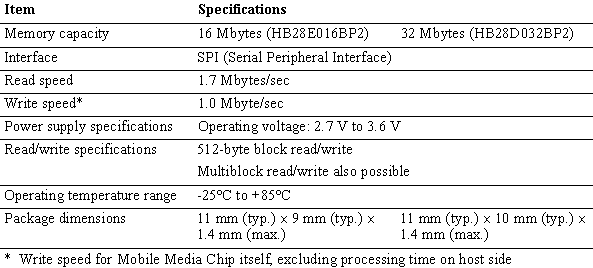
Mobile Media Chip
Left : Package Right : Inside
Tokyo, October 22, 2001 -Hitachi, Ltd. (TSE: 6501) today announced
two Mobile Media Chips with AND-type flash memory and its controller
mounted in a small package, for data storage use in small mobile devices
such as mobile phones and PDAs. Sample shipments will begin on October
23, 2001, for the 16-Mbyte (128-Mbit) HB28E016BP2, and in December
2001 for the 32-Mbyte (256-Mbit) HB28D032BP2 in Japan.
These two products employ a small 71-pin FBGA (Fine-Pitch Ball Grid
Array) package to allow their use in small devices, offering the industry's
smallest mounting areas of 11 mm  9 mm (typ.) for 16-Mbyte (128-Mbit) flash memory and 11 mm
9 mm (typ.) for 16-Mbyte (128-Mbit) flash memory and 11 mm  10 mm (typ.) for 32-Mbyte (256-Mbit) flash memory.
10 mm (typ.) for 32-Mbyte (256-Mbit) flash memory.
A controller handling complex control such as AND-type flash memory
faulty sector management and ECC (Error Correcting Code) management
is also incorporated, simplifying embedding in an end-product and
reducing the processing load on the CPU.
[Background]
With the ever greater volumes of information associated with the increasing
functionality of small mobile devices such as mobile phones, PDAs,
and digital cameras, and the popularity of various kinds of content
distribution using communication functions, the trend is one of increasing
memory capacity in these devices. While it is possible for flash memory
suitable for data file storage to be incorporated directly into such
devices, complex new flash memory file management systems need to
be designed and these impose an additional processing load on the
CPU.
With these considerations in mind, Hitachi has developed Mobile Media
Chips that simplify user system design and reduce the processing load
on the CPU by incorporating a controller to handle such kinds of control
together with flash memory in a single package.
[About this Product]
In these two new products a controller is stacked above the industry's
smallest AND-type flash memory in a single package, achieving both
large capacity and the industry's smallest mounting area. The 16-Mbyte
HB28E016BP2 incorporates 128-Mbit flash memory in an 11 mm  9 mm
9 mm  1.4 mm (max.) package
size, while the 32-Mbyte HB28D032BP2 incorporates 256-Mbit flash memory
in an 11 mm 1.4 mm (max.) package
size, while the 32-Mbyte HB28D032BP2 incorporates 256-Mbit flash memory
in an 11 mm  10 mm 10 mm  1.4 mm (max.) package size. These sizes are approximately half those
of Hitachi's TSOP packages.
1.4 mm (max.) package size. These sizes are approximately half those
of Hitachi's TSOP packages.
By also incorporating a controller used for MultiMediaCardTM*1
miniature flash cards, the faulty sector management and ECC management
characteristic of AND-type flash memory can be carried out within
the Mobile Media Chip, simplifying embedding in the end-product.
The SPI (Serial Peripheral Interface) mode provided for the interface
is widely used commercially, and is also used for MultiMediaCards.
There is consequently no need to develop new driver software for an
end-product that already uses a MultiMediaCard, and embedding design
can be carried out using the same file system environment.
[Development Support Tools]
When designing a system using a Mobile Media Chip, the same support
tools can be used as for Hitachi MultiMediaCards. Driver, file manager,
and other software*2, hardware such as an H8S
microcomputer based development platform, and also system analysis
tools such as a dedicated MultiMediaCard protocol analyzer*3
are available from third-party suppliers.
Future plans include the development of larger-capacity models to
provide a comprehensive Mobile Media Chip lineup.
| Notes: |
1. |
MultiMediaCard is a trademark of Infineon Technologies
AG of Germany, and is licensed to the MMCA (MultiMediaCard Association).
Hitachi is an MMCA board member. http://www.mmca.org/
|
| 2. |
Driver and file manager software is marketed by
AI Corporation in Japan.
|
| 3. |
An H8S microcomputer based development platform
and dedicated MultiMediaCard protocol analyzer are marketed by
KOKUSAI ELECTRIC ALPHA CO., LTD. |
< Typical Applications >
 |
Portable imaging products such as digital
video cameras and digital cameras |
 |
Handheld PCs, palm-size PCs, PDAs,
electronic organizers, and similar portable information devices |
 |
Mobile phones with music download/playback
functions, portable music players, toys, game machines, and similar
portable entertainment products |
 |
Portable communication devices such as smart phones
and pagers |
< Prices in Japan >(For Reference)

< Specifications >

|